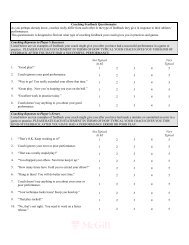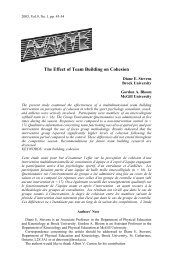International Journal of Sport Psychology
International Journal of Sport Psychology
International Journal of Sport Psychology
You also want an ePaper? Increase the reach of your titles
YUMPU automatically turns print PDFs into web optimized ePapers that Google loves.
Applied sport psychology consultant perceptions<br />
<strong>of</strong> the usefulness and impacts <strong>of</strong> performance pr<strong>of</strong>iling<br />
NEIL J.V. WESTON*, IAIN A. GREENLEES**, and RICHARD C. THELWELL*<br />
(*)University <strong>of</strong> Portsmouth, U.K.<br />
(**)University <strong>of</strong> Chichester, U.K.<br />
360<br />
Despite the apparent widespread use <strong>of</strong> Butler and Hardy’s (1992) performance<br />
pr<strong>of</strong>iling procedure (Doyle & Parfitt, 1999), there is limited research detailing<br />
the benefits that can accrue from its use. Hence, the present investigation<br />
sought to provide an evaluation <strong>of</strong> sport psychologists’ perceptions <strong>of</strong> the usefulness<br />
and impacts <strong>of</strong> performance pr<strong>of</strong>iling. Fifty-six British Association <strong>of</strong> <strong>Sport</strong> and<br />
Exercise Sciences accredited sport psychologists completed a closed survey detailing<br />
their perceptions <strong>of</strong> the usefulness and benefits associated with the production <strong>of</strong> an<br />
individual athlete performance pr<strong>of</strong>ile within a group setting. Descriptive analysis<br />
revealed that consultants believed pr<strong>of</strong>iling to be useful in providing a basis for goal<br />
setting, identifying strengths and weaknesses, raising athlete awareness, evaluating<br />
and monitoring athlete performance, and in facilitating discussion, communication<br />
and interaction within teams.This brief report argues that further research is<br />
needed to empirically evaluate the usefulness <strong>of</strong> pr<strong>of</strong>iling in order that its frequent<br />
use can be fully justified.<br />
KEY WORDS: Initial assessment, Performance pr<strong>of</strong>ile, Psychologist opinions,<br />
Survey.<br />
Several methods <strong>of</strong> sport psychological assessment have been identified<br />
in the literature including questionnaires (O’Connor, 2004), interviews<br />
(Lloyd & Trudel, 1999), and behavioral observation (Tkachuk, Leslie-Toogood,<br />
& Martin, 2003). Another frequently employed sport psychological<br />
assessment strategy is the performance pr<strong>of</strong>ile (Butler, 1989; Butler & Hardy,<br />
1992; see figure 1 for an example pr<strong>of</strong>ile). Drawing upon selected principles<br />
<strong>of</strong> Personal Construct Theory (PCT; Kelly, 1955), Butler and Hardy developed<br />
a client centred, idiographic performance analysis tool which asked<br />
athletes to identify the attributes essential to their performance (e.g., technical,<br />
physical, psychological qualities) and then rate themselves on those<br />
For correspondence: Dr. Neil Weston (E.mail: neil.weston@port.ac.uk)<br />
Int. J. <strong>Sport</strong> Psychol., 2010; 41: 360-368




